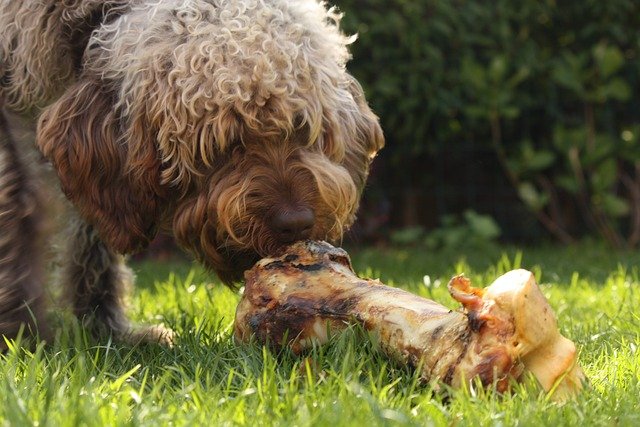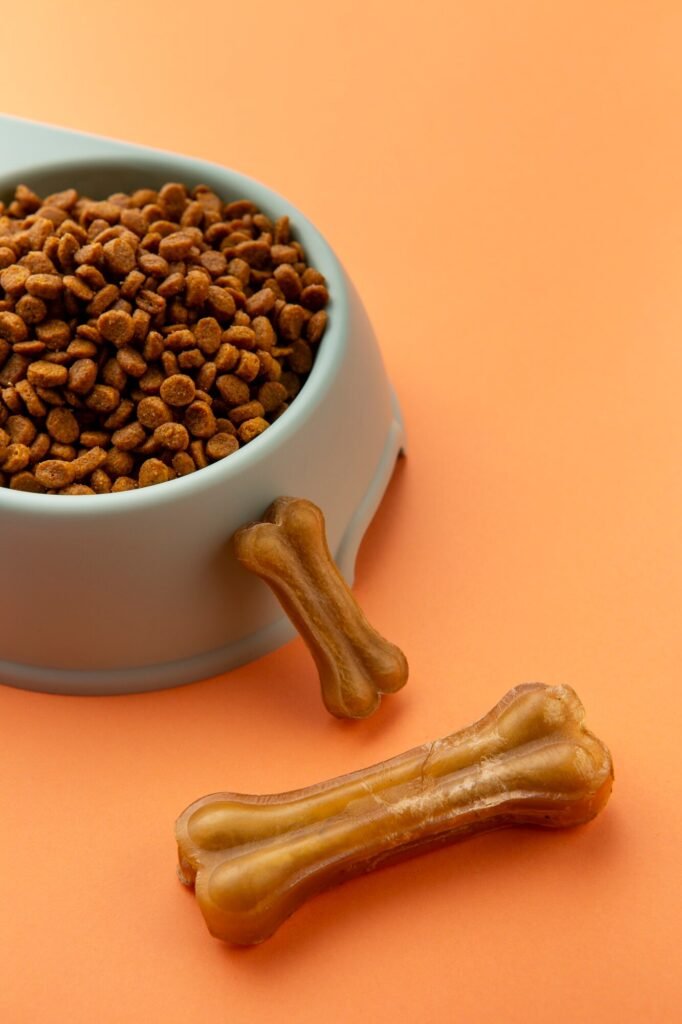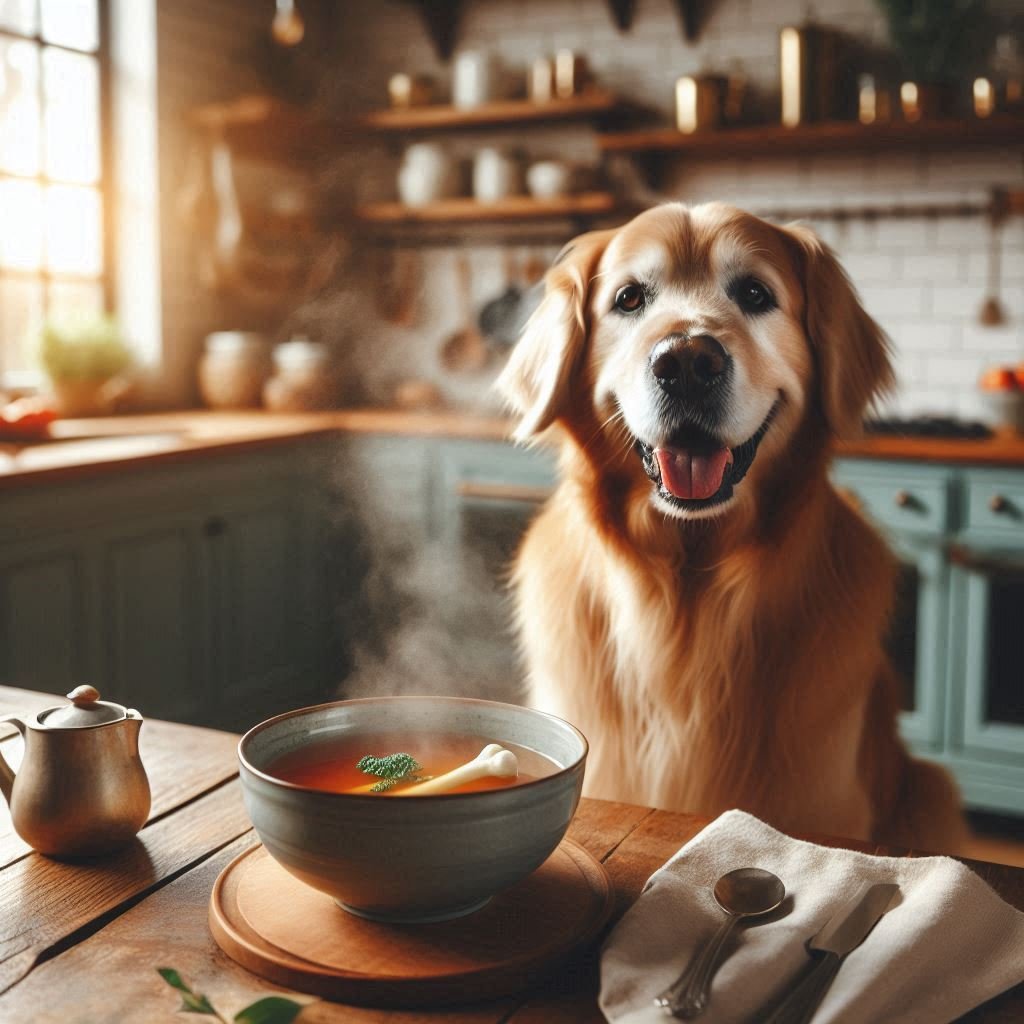Bone broth has been gaining popularity recently as an addition to a dog’s diet, thanks to its high line of nutrients including collagen, amino acids and essential minerals. But its global reputation, particularly among humans, is nothing new — and now that more and more pet owners are learning about its benefits, it’s starting to get some notice as a PET product, too. However, is bone broth good for dogs? While it still hasn’t been proven 100 percent effective, there’s some research that suggests it can even improve hydration and promote overall good health to your pet. But there is another thing to acknowledge here: While it contains health benefits, it shouldn’t be thought of as a replacement for a well-rounded diet. However, it’s a supplement to it instead.

Table of Content
- What is Bone Broth?
- Consider theses Benefits of Bone Broth for Dogs
- Making Bones Broth at Home for Dogs
- “Bone Broth Soup for Dogs”: Serving Ideas
- Bone Broth: Potential Risks for Dogs
- “Chicken or Bone Broth for Dogs?” What’s Best?
- Conclusion
What Is Bone Broth?
Bone broth is simply a terrific source of some of the most nutrient dense liquid. it is thick, savory and rich in a liquid that’s been bone and connective tissue for a good long while. It does this because it is obtained after a slow cooking process that extract amino acids, vitamins, essential minerals, etc. As a convenient, easily absorbed source of these nutrients, the broth comes from the body. Bone broth has traditionally been consumed by humans. But now is being recognized as a real part of a pet feed.
With bioavailable vitamins and minerals packed in bone broth, it has a wide range of benefits for dogs’ health, including better skin and coat as well as joint health. Salt, garlic and onions are all potentially dangerous for your dog when they buy or make you any good old-fashioned bone broth.
Consider These Benefits of Bone Broth For Dogs
Pet owners are starting to turn more and more to make and use it to help keep their pets healthy naturally. Here are some of the most notable benefits associated with bone broth for dogs:
Hydration Boost
Probably one of the most hydrating things your pet can eat. This is really useful if your dog will not drink water. The smell and taste of it fans the flames even getting the most fretful drinkers to drink what is needed for optimal hydration.
Joint Health Support
It contains all the collagen, glucosamine and chondroitin that is needed for healthy joint cartilage. The other nutrients may assist in decreasing inflammation, enhancing joint mobility and improve general function in older dogs.
Healthier Skin and Coat
It’s collages include amino acids such as glycine and proline which some believe promote skin elasticity and skin health in general. Taken regularly, these nutrients can be added to your dog’s diet to provide what you would think of as a shiny, healthy coat and help prevent dryness or flakiness.
Digestive Health
Finally, because it contains gelatine, it is especially beneficial for dogs with sensitive stomachs or digestive issues. A healthy lining of the digestive tract is essential for overall digestive fitness, and cooling may help lessen digestive stress.
Nutritional Benefits
However, there is a technique to use it to give your dog extra nutrition. For dogs on restricted diets or those who have recently recovered from sickness, this is quite helpful as it provides all the readily digested vitamins, minerals, and amino acids.
What should you consider while giving it your pet?
It may offer several advantages; nonetheless, it should just serve as an adjunct to a balanced diet. Excessive dependence on a single dietary item hinders the acquisition of essential nutrients. Prior to incorporating it into your dog’s diet, regardless of its form, or any other new food, it is imperative to consult your veterinarian, particularly if your dog has preexisting health issues or dietary limitations.
Additionally, when buying or making it for dogs, do not buy such bones or broth that contain harmful ingredients, for example “is” or “garlic” or “onions” as they are toxic for pets.
How to Make Your Own Bone Broth For Your Dogs at Home
Getting your dog to eat it is not hard, it’s a nutrient dense supplement that will help keep your dog healthy. Here’s a simple recipe to get started:
Ingredients:
Unseasoned beef or chicken bones, 1 to 2 pounds. Use either chicken or beef bones alternating as your dog favors. While the vitamin A you find in carrots won’t help your dog much (the vitamin A they obtain from the carrots in pets is biologically different), it does provide them with multiple additional nutritional benefits.
- 6 to 8 cups of water
- Optional: Vegetables like carrots or celery added in for pet safe nutrition
Instructions:
- Prepare the Bones: Put the beef or chicken bones, as many as you need to fit loosely, into the large pot.
- Add Water: Once that is done, pour enough water to make sure there is water covering the bones. The slow cooking process will allow the nutrients to be extracted during this.
- Simmer Slowly: Simmering gently for 8 to 24 hours, set the heat to low. This allows all the nutrients to be extracted that will be from the bones.
- Strain the Broth: After, strain carefully to leave it without any bits of vegetables or bone, and you want to the broth to be smooth and safe for your dog to eat.
- Cool and Serve: The broth needs to cool before eating. You can serve it alone as a tasty treat, or as a nutritious topping to your dog’s regular meals.
Refrain from adding salt, condiments, or foods like as garlic or onions, since they are unsafe for dogs. Prior to implementing significant alterations to your dog’s food, regardless of his nutritional requirements or health issues, it is imperative to consult your veterinarian first.
“Bone Broth Soup for Dogs”: Serving Ideas
If your dog is going to eat it, it’s important to take some safety measures to keep your dog healthy. Instead, first, don’t use any seasoning, especially salt, because even least amounts of these can be harmful to cats. Make sure there are no toxic ingredients in the broth by always referring to the ASPCA’s safe vegetable list. Remember also never to feed cooked bones to your cat, as they can split (and provide choking hazards or internal injuries).
When you create bone broth at home, you can prepare your dog a nutrient packed, tasty diet supplement you know what went into it. Just as a mindful approach to your food can add richness to your meals and help with your overall health and vitality, a mindful approach to your pet’s food can lead to more enriched meals and better overall health and vitality on the part of your pet.
Bone Broth for Pets: Serving and Storing
It can contain beneficial nutrients for your pet and also add flavor. But to enjoy everything from your pet, you need to serve and store it properly.

How to Serve Bone Broth:
As a Meal Topper:
To squirt some extra moisture and flavor in your pet’s regular food, pour cooled bone broth over top. Besides making dry kibble more palatable, it can also function as a gravy to wet food. Serve only when the broth is at a safe temperature.
Frozen Treats:
To keep you cool when it’s hot, freeze bone broth in ice cube trays or silicone molds. Feed no more than one cube per day to smaller pets to avoid stomach upset.
Hydration Aid:
One of the reasons why bone broth can be such a good way to get rein in your pet’s hydration levels, is because pets don’t nurse naturally these days. If your pet is recovering from illness or the slightest in the appetite, serve it in a bowl as a delicious drink.
How to Store Bone Broth:
After the broth brings up to room temperature, put it in airtight containers or jars. Refrigerate store for 3-4 days. The broth is also recommended to be frozen if not consumed within this time as freezing will help to stop spoilage.
To store longer, freeze bone broth into parts like an ice cube tray. Once frozen, place the cubes in freezer safe bags or containers. Refer them with the date. You can freeze bone broth for a maximum of three months.
Thaw frozen broth in refrigerator overnight or gently heat in a pan on stove when ready to serve. Never serve it to your pet unless it is at a safe temperature.
Safety Considerations:
Cooked bones must not be added to the broth. Always extract cooked bones from the broth before to feeding to avert splintering, which poses a significant risk to your pet’s health. Avoid feeding animals substances such as onions, garlic, or excessive salt, as they might be poisonous.
In order to add bone broth to your pet’s diet safely, incorporate these safety practices to your routine. The good news is, bone broth can become a simple yet powerful way to help increase your pet’s overall wellbeing and mealtime will be even more enjoyable when prepared and stored mindfully.
What Are the Potential Risks of Bone Broth for Dogs?
Bone broth is healthy for pets, but pet owners need to be aware of potential risks before using it. Below are key considerations to ensure the safe incorporation of bone broth into your pet’s diet:
Sodium Levels
Even homemade bone broth recipes will likely contain too much sodium, especially if salt is added during preparation. Pets have health issues of high blood pressure and kidney damage associated with excessive sodium. This will prevent these risks, never add salt to the broth and use unsalted bones to be on the safe side.
Harmful Ingredients
Onions and garlic are often high on the list of those used in human cooking and, unfortunately, highly toxic to pets. You should never feed your pets any of these ingredients in bone broth. Use pet safe ingredients and reference as many reliable sources as you can to make sure all your ingredients in your recipe are safe for your fur baby.
Risks of Cooked Bones
When making bone broth for pets, using raw or unseasoned bones is important because cooked bones can splinter very easily. These can cause internal damage, or worse, they can pose choking hazards. When making a stock from giblets, always strain the broth well to remove small bone fragments before serving to your pet.
Supplemental Use Only
Bone broth may be incorporated into your pet’s regular diet as a supplement; it is not a comprehensive food. While bone broth is nourishing, it does not imply that you have been depriving yourself of other essential vitamins, minerals, and elements required for a balanced diet. You should consult a veterinarian on the appropriate amount of bone broth to incorporate into your pet’s diet.
Managing Caloric Intake
Bone broth, while full of flavour, is not a calorie- nor a nutrient-dense food. It shouldn’t be relied upon very much at all, as unnatural things can lead to an unbalanced diet, and nutritional deficiencies in your pet. Bone broth should be used as a special treat, or meal topper, within an overall diet of a veterinarian approved diet.
Understanding these side effects are a possibility, you should have no fear of adding the bone broth into the daily routine for your pet and knowing the bone broth will not be taking away from their health. Never add any new food to your pet’s meal plan unless you know your pet’s dietary needs are being met, check with a veterinarian first.
“Chicken or Bone Broth for Dogs” …? What’s Best?
There’s also no argument about the fact that chicken or beef bone broth is good for your dogs when choosing which one to opt for. Chicken broth is usually lighter, easier to digest stuff so it’s usually the best thing for dogs with sensitive stomachs. However, beef bone broth tends to be more flavourful and more nutritious. If you are trying to give your dog a well-rounded variety to his diet, then alternation the two. It also adds in a rotation to your pet’s meals giving it the mildness of chicken and the richness of beef at the same time.
Conclusion
Did you know that including bone broth into your dog’s meal can provide benefits such as hydration, intestinal health, enhancements to skin and joint condition? While pet owners must recognize the possible hazards of utilizing inappropriate materials or improperly cooking the food, the majority of canines like the meal. Incorporating this nutritious supplement into your pet’s diet is straightforward, provided you adhere to safety protocols and consult your veterinarian. This will result in a joyful and healthy existence for your pet.



One Response